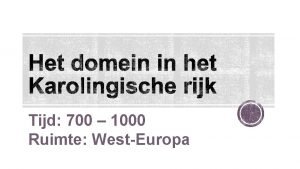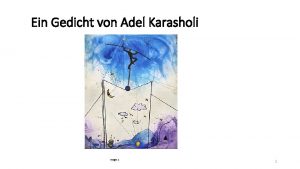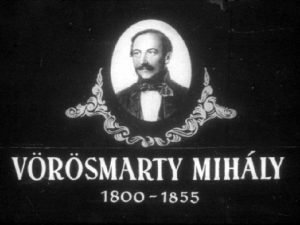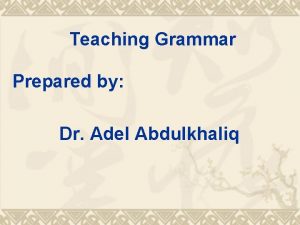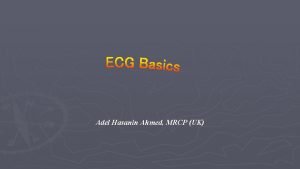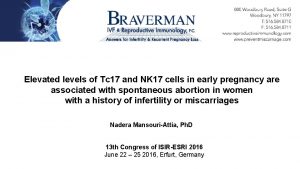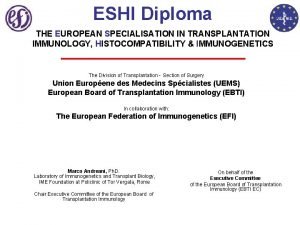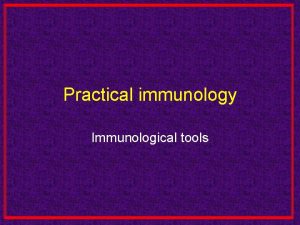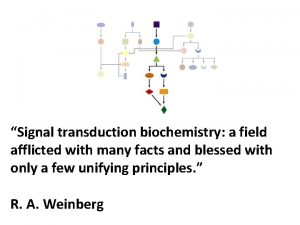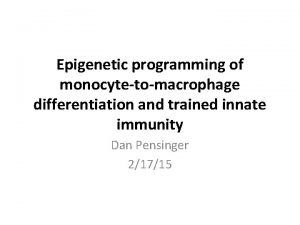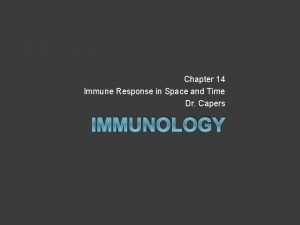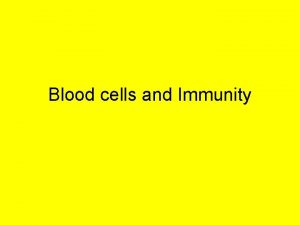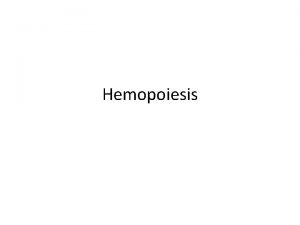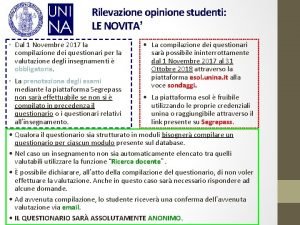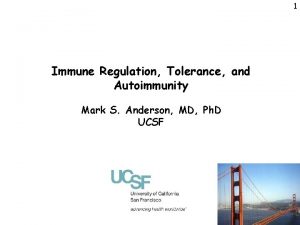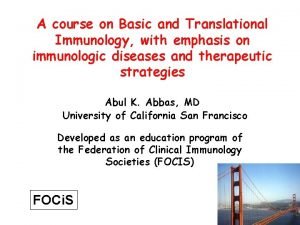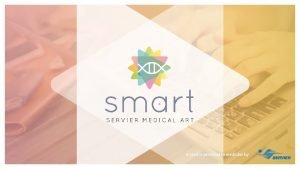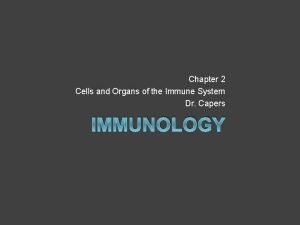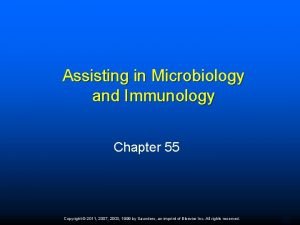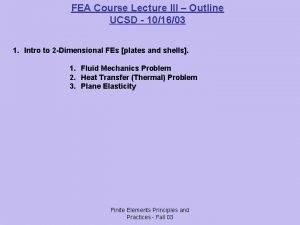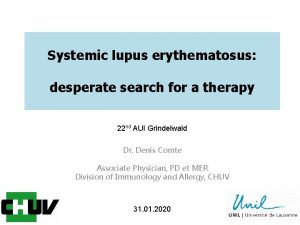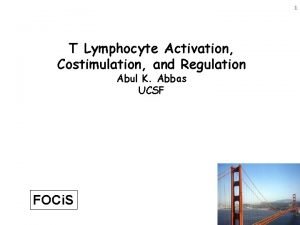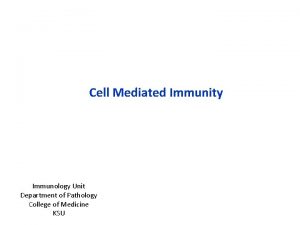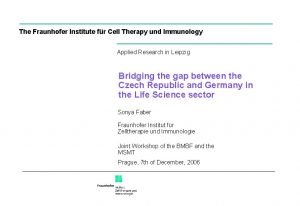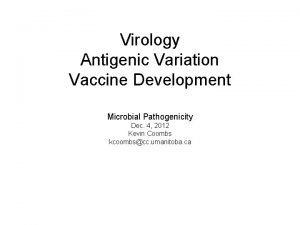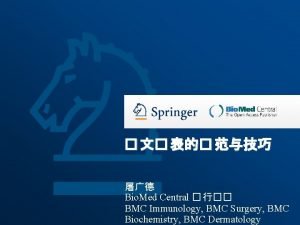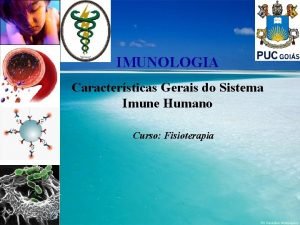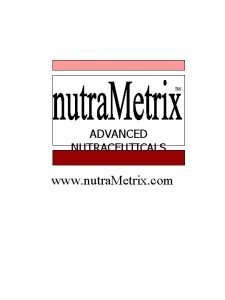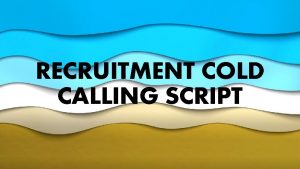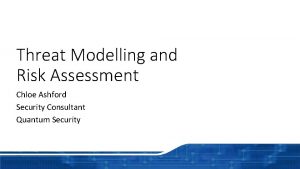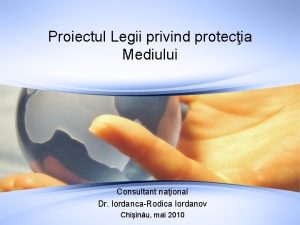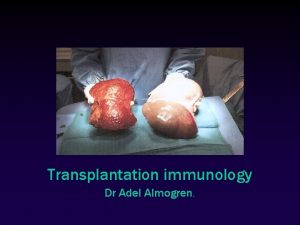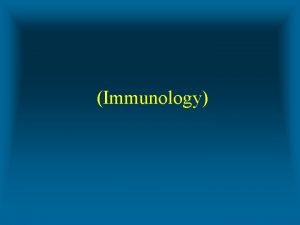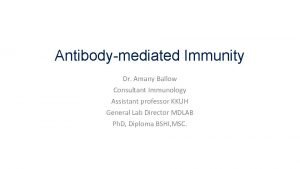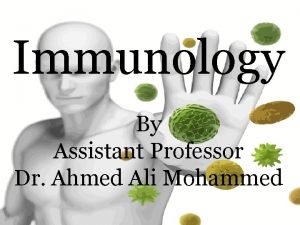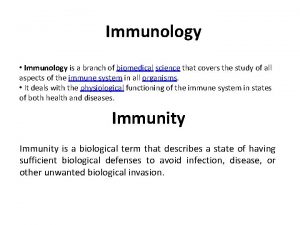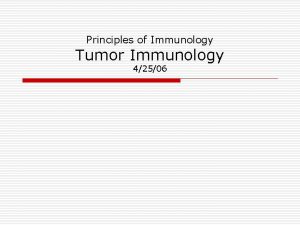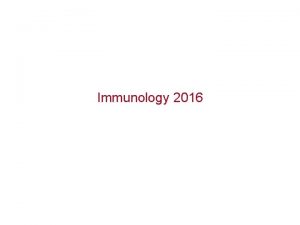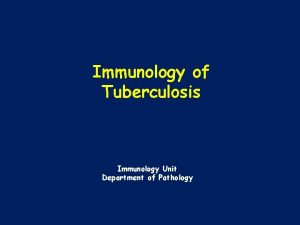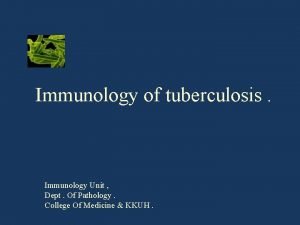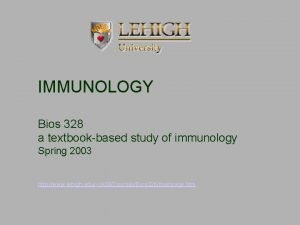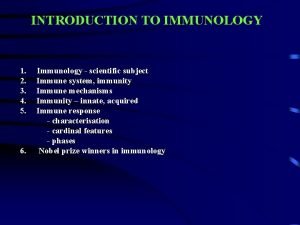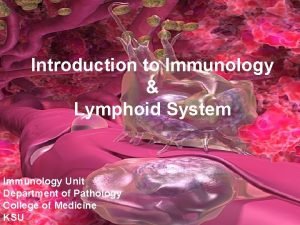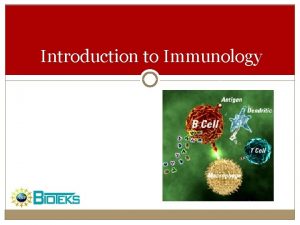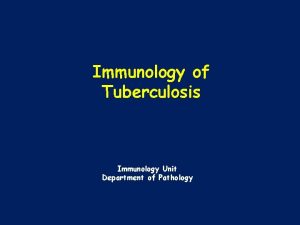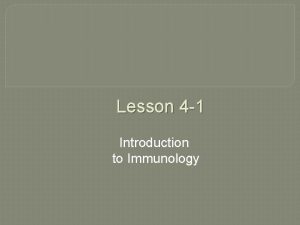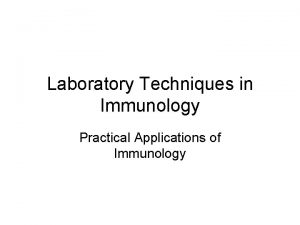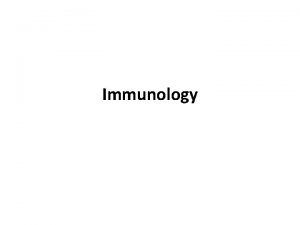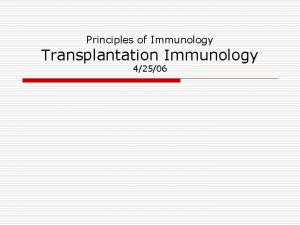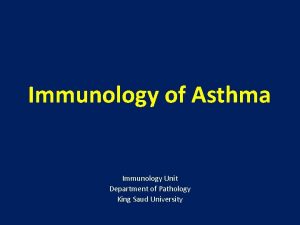Dr Adel Almogren Assistant Professor of Immunology Consultant










































- Slides: 42

Dr. Adel Almogren Assistant Professor of Immunology Consultant Immunologist Dept. of Pathology/ Immunology Unit Email: almogren@ksu. edu. sa Office: 467 -1843

Soluble mediators secreted by a large variety of cells Act via interactions with specific receptors on target cells Regulate immune cells / functions. Nomenclature? ! Lymophkine / Monokine/ Chemokine/ Interleukin/ Interferon/ TNF

1 2 3 4 6 5

Properties of Cytokines Low-molecular weight (< 30 k. Da) proteins or glycoproteins Monomeric or polymeric Bind with very high affinity to specific receptors Trigger specific signal transduction pathways alteration of gene expression

Biological Activities Regulated by Cytokines Hematopoiesis Cell proliferation and differentiation Inflammation Innate Immunity Adaptive Immunity Cellular immunity Humoral immunity

Cytokines Mode of Action I Autocrine Paracrine Close proximity Endocrine Distant cells

Cytokines : Mode of Action II Pleiotropic Cascade induction Redundant Synergistic Antagonistic -

Factors that Influence the Mode of Action of Cytokines Interaction of Cytokines with their Receptors Analysis of function 1º cytokines: IL-1, TNF >>> NF-k. B pathways (IL-18) 2º cytokines: their production is induced after cell stimulation by IL-1 and/or TNF. Cytokine Structural families Hematopoetins a helical structures Few or no b -sheet IL-3, IL-4, IL-5, IL-6, IL-7, IL-15, GM-CSF Interferons IFN-g, IFN-a/b Tumor necrosis factors TNF-a, LT-a / TNF-b Chemokines IL-8, RANTES, MIP,

Factors that Influence the Mode of Action of Cytokines Interaction of Cytokines with their Receptors Cytokine Receptors families Immunoglobulin superfamily IL-1, M-CSF, c-Kit Hematopoetins Class I cytokine receptor IL-3, IL-4, IL-5, IL-6, IL-7, IL-15, GM-CSF Interferons Class II cytokine receptor IFN-g, IFN-a/b Tumor necrosis factors TNF-a, LT-a / TNF-b Chemokines IL-8, RANTES, MIP,

Cytokine Receptors Multiple polypeptide chains (subunits) à Cytokine binding subunit(s) à Signal-transducing subunit (s) Many cytokine receptors share common signal-transducing subunits (pathways) Signal transduction mediated by cytokine receptors: of central importance are the NF-k. B pathway and JAK-STAT pathway

NF-k. B signaling • • • Agonist binding to cell surface receptor. Induction of Ik. B kinase (IKK) activity. Phosphorylation and ubiquitination of Ik. B. Degradation of Ik. B by 26 S proteasome. NF k. B release and nuclear translocation. Transcription of NF-k. B responsive genes. JAK-STAT signaling • • Ligand binding triggering receptor oigomerization. Activation of tyrosine phodphorylation by Jak kinase. Docking of SH 2 domain proteins including specific STATs. STAT Phosphorylation, dimerization, and gene transcription.

Factors that Influence the Mode of Action of Cytokines Subfamily of Cytokines Shared Receptors And Signaling pathways Jaks STATS Jak 1, Jak 3 Stat 3, Stat 5 a, Stat 5 b Stat 6 Jak 2 Stat 5 a, Stat 5 b Jak 1, Jak 2 Stat 3 Jak 2, Tyk 2 Stat 4 IFN-g IFN-a, IFN-b Jak 1, Jak 2 Jak 1, Tyk 2 Stat 1, Stat 2 IL-10 Jak 1, Tyk 2 Stat 3 Receptors share a common g chain IL-2, IL-7, IL-9, IL-15 IL-4, Receptors share b chain IL-3, IL-5, GM-CSF Receptors share gp 130 IL-6, IL-11 Receptor related to gp 130 IL-12 Interferon

Factors that Influence the Mode of Action of Cytokines Expression of cytokine receptors limited or upregulated on antigen-activated cells Secretion of cytokines Induced or upregulated by direct interaction between cells (i. e. , APCs and T cells) Half life of cytokines Short Cytokine Antagonists Cytokine receptor antagonists (IL-1 Ra) Cytokine mimics or cytokine binding proteins Contribute to the specificity of immune responses

Cytokine Regulation Of Immune Responses Innate Immune Responses Mediated by Phagocytes (MØ, Neutrophils) and NK cells Involve Inflammatory Cytokines: TNF-a, IL-1, and IL-6 Chemokines: CXC, CX 3 C Interferons: IFN-g, IFN-a / b (Type-I IFNs) Adaptive Immune Responses Mediated by effector B and T cells Involve: T helper cell cytokines

T Helper Cells Effector function restricted to cytokine secretion Two subsets based on the pattern of cytokine secreted and immune responses promoted Th 1 Cell mediated immunity Th 0 CD 4+ T cell Th 2 Humoral immunity Th 1 and Th 2 cell cytokines reciprocally regulate differentiation of the other subset

Th 1 / Th 2 Cell Subsets p. Th IL-2 IFN-g LT-a Th 1 Th 0 IFN-g IL-4 Th 2 IL-4 IL-5 IL-6 IL-9 IL-10 IL-13

Th 1 / Th 2 Cell Subsets In Various Diseases Th 1 Dominant Tuberculosis Type 1 Diabetes Mellitus Inflammatory Bowel Diseases (IBD) Parasitic Infections Th 2 Dominant Allergy Asthma Inflammatory Bowel Diseases (IBD) Normal. Pregnancy Multiple Sclerosis Tumors Recurrents Abortions Parasitic Infections (Schistosoma) Rheumatoid Arthritis Tumor Progression Acute Allograft Rejection Progression to AIDS

Pregnancy is a Th 2 biased “Disease” Fetus : foreign organism (allograft) Normal Gestation : No rejection of graft Cytokine secreted by PHA-stimulated PBMCs Normal Gestation Th 1 IL-2, IFN-g TNF-a, TNF-b Th 2 IL-4, IL-5 IL-6, IL-10 Recurrent Spontaneous Abortions Raghupathy R, 2000. Hum Reprod 15: 713

Th 1 / Th 2 Cell Subsets Differentiation Nature and dose of antigen Environment factors (cytokines) Cross-regulation IL-4 IFN-g Distinct effects on immune responses Th 1 Phagocytic Cell Mediated Immunity (activation of MØ, neutrophils and NK cells) Complement fixing Abs for Opsonization Th 2 Humoral immunity Ig. G 1, Ig. E (IL-4) Activation of Eosinophils (IL-5)

Cytokine Regulation of Macrophage Functions IFN-g “Resting” Macrophage + Activated Macrophage IL-10 Low No or Low MHC and co-stimulatory molecules Inflammatory cytokines (IL-1, IL-6, IL-12, TNF-a) Chemokines (IL-8) Toxic oxygen radicals High

Examples of some cytokines functions • IL-5 & TGF-b induces class switch to Ig. A • IL-4 Up-regulates MHC II expression » With IL-5 Induce switch to Ig. E • IL-10 Down-regulates MHC II expression • IL-2 & IL-12 Synergisitically induce differentiation into CTL • Interferon a/b Inhibition of viral replication • Interferon g +Immunoregulatory process; switching to certain Ig. G subclasses, mononuclear phagocytosis. • IL-18 induction of INF- g

Allergy Excessive Th 2 responses in atopic individuals Many common allergens are delivered to the nasal mucosa by inhalation of low doses of antigen Presentation of a low dose of antigen favors the activation of Th 2 over Th 1 cells. Approaches to treatment of allergy Desensitization: Shift Th 2 (Ig. E) Th 2 (Ig. G) Injection with escalating doses of allergen + adjuvant Cytokine therapy: Reduce Ig. E responses IFN-g, IL-12, TGF-b, IL-4 R Inhibition of eosinophil recruitment: eotaxin receptor CCR-3 (on Th 2 cells)

Th 1 / Th 2 Cell Subsets In Various Diseases T Helper Cells In Multiple Sclerosis And Autoimmunity Cytokine profiles in patients with progressive multiple sclerosis Increased IL-12 production by monocytes Increased IFN-g production by T cells Comabella M, 1998. J Clin Invest 102: 671.

Cytokine-related diseases Ø Bacterial septic shock: Bacterial cell-wall endotoxins stimulate MǾ to overproduce IL-1 and TNF-a Ø Bacterial toxic shock: TNF and IL-1 ØLymphoid and myeloid cancers: Levels of IL-6 are secreted by; cardiac myxoma cells, myeloma and plasma-cytoma cells, and cervical and bladder cancer cells. Ø Chaga’s disease: expression of the a subunit of IL-2 receptor

Clinical applications Recombinant cytokines – enough – safety - FDA and EC approval – clinical relevance Which diseases • auto-immune disease • infectious diseases • immuno-deficiencies • malignancy

Auto-immune disease r-human insulin – for type 1, insulin-dependent diabetes rs. TNFR – effective in RA, better than anti-TNF, effects transient IFN-alpha – Multiple sclerosis. Erythropoetin – anaemia of chronic renal failure (NB kidney synthesis) IFN-gamma – decrease collagen in Scleroderma - doubtful benefit.

Infectious disease IFN-alpha • Hepatitis B - conversion of Hep B antigen positive to negative, reduction in infection spread, improvement in pathology • Hepatitis C - may cure infection or at least lead to remission while on treatment (in combination with ribovirin). • Papilloma virus - benficial for genital and common warts. • HIV and Kaposi’s sarcoma - no significant benefit. Interferon-gamma • Leprosy - beneficial in lepromatous leprosy. • Leishmaniasis - beneficial in visceral leishmaniasis • Toxoplasma - used as experimental therapy. IL-2 and IFN-alpha, IFN-gamma • HIV - no benefit

Malignancy Malignant disease • IL-2 (LAK cells) • Melanoma trials disappointing (limited by side effects) • Renal cell carcinoma small uncontrolled trial show some benefit • IFN- alpha • Hairy-cell leukaemia treatment of choice self-administered at home • Chronic myeloid leukaemia Thought to be toxic for Phi chromosome positive cells.

Malignancy Treatment of malignant disease • Autologous stem-cell harvest G-CSF increases the circulating CD 34+ stem cells. • Post-chemo- or radio-therapy G-CSF / GM-CSF shortens the neutropoenic period. • Post BMT G-CSF / GM-CSF / IL-3 hastens engraftment in autologous transplants • Myelodysplasia GM-CSF / IL-3 / EPO to encourage recovery

Immune-deficiency • Vaccination – adjuvant incorporate cytokine gene sequence eg. IL-12 into vaccines vector (animal models) • Primary Immunodeficiencies - IFN-gamma • chronic granulomatous disease (CGD) – partially corrected defect - acute treatment for abscesses, low-dose prophylactic therapy. Thought to work by increasing bactericidal activity of neutrophils by unknown mechanism. • hyper-Ig. E syndrome – based on theoretical Th 2 imbalance

Cytokines - other applications • Erythropoetin - anaemia of chronic renal failure and dialysis (NB kidney synthesis) • Fibroblast Growth Factor for wound healing, recalcitrant ulcers, non-healing fractures. • Pregnancy- survival of the ‘allograft’, very high secretion of M-CSF from endometrial cells, also high levels of TGF-beta in amniotic fluid.

Therapeutic Uses of Cytokines * TNF a in inflammatory diseases RA, psoriasis New clinical drugs targeting TNF pathway: Humanized anti-TNF a antibody inflixmab (Remicade) Soluble TNF receptor etanercept (Enbrel) not all AID <MS> * INF type I >>>>> melanoma and cutaneous lymphoma * Systemic cytokines

Cytokines Available in Canada Trade Name (Manufacturer) Disease Treated Cytokine Type Interleukin Aldesleukin (IL-2) Interferon Alfa 2 b Interferon Alfa 2 a Interferon Alfa. Con 1 Interferon Beta 1 a Interferon Beta 1 b Proleukin. TM (Chiron Corp) Cancer Intron ATM (Shering Canada Inc) Roferon-ATM (Hoffmann La-Roche Ltd) Skin Cancer Hepatitis B and C, and various cancers. Hepatitis C Multiple Sclerosis (MS) Infergen. TM (Amgen Canada Inc) Rebif. TM (Serono Canada Inc) Avonex. TM (Biogen Canada Inc) Betaseron. TM (Berlex Canada Inc) Erythropoietin Epoetin Alfa Colony Stimulating Factors FILGRASTIM (R-METHUG-CSF) Eprex. TM (Janssen-Ortho Inc) Neupogen. TM (Amgen Canada Inc) Anaemia associated with poor kidney function, chemotherapy, and reducing the need for external blood transfusions for surgery patients. Post chemotherapy, and bone marrow transplant patients who have compromised immune systems.

Therapeutic Uses of Cytokines Advantages Known ligands, receptors and mechanisms of action Problems Short half life Toxicity of high repeated doses Broad effects (redundancy) Alternatives Cytokine receptors Alternative delivery routes (skin)

Interleukins - 1 • This nomenclature started in 1979. For this designation – the gene sequence of the protein must be unique. – the protein will have also been cloned (c. DNA) – the recombinant protein (eg, r. IL-1) shown to have the same activity as the native purified molecule. • IL-1 can be produced by all nucleated cells, has a wide range of biological activities on many target cell types. In vivo it induces hypotension, fever, weight loss, neutropoenia and acute phase response. Main function is as a dendritic cell-derived factor which specifically promotes the proliferation of T lymphocytes.

Interleukins - 2 • IL-2 is a T-cell-derived cytokine which was first described as a T cell growth factor. Now known to stimulate growth and differentiation of T, B, NK cells, monocytes, macrophages and oligodendrocytes. • IL-3 is a haematopoetic growth factor which stimulates colony formation of erythroid, megakaryocyte, neutrophil, eosinophil, basophil, mast cell and monocyte lineages.

Interleukins - 3 • IL-4 from T-cells and mast cells and acts on Bcells, T-cells, endothelial cells and fibroblasts. It induces the secretion of Ig. E and Ig. G 4 by B-cells. It shares this property with IL-13. • IL-5 is a T-cell derived glycoprotein which stimulates eosinophil colony formation and is an eosinophil differentiation factor. • IL-6 is multifunctional, secreted by lymphoid and non-lymphoid cells. It regulates B-cell function, haematopoesis and the acute phase response.

Interleukins - 4 • IL-7 is a stromal-cell derived factor for progenitor B-cells and T-cells. The main lymphocyte population in the thymus responsive to IL-7 is CD 4 -ve/CD 8 -ve. IL-7 also promotes growth and differentiation of mature T-cells. • IL-8 is an inflammatory cytokine, produced by many cell types, which functions as a neutrophil chemo-attractant and activation factor. It also attracts basophils and a subpopulation of lymphocytes. It is a potent angiogenic factor. • IL-9 enhances the proliferation of T-lymphocytes, mast cell lines and erythroid precursors.

Interleukins - 5 • IL-10 is secreted by TH 0 and TH 2 subsets of CD 4 lymphocytes. It blocks activation of cytokine synthesis by TH 1 lymphocytes, activated monocytes and NK cells. It stimulates or enhances the proliferation of B-cells, thymocytes and mast cells and it co-operates with TGF beta to stimulate Ig. A production by human B-cells. There is a high degree of homology between IL-10 and an open reading frame (BCRF 1) in the EBV genome. The protein encoded has some of the activities of IL-10 and has been designated v. IL-10. • IL-11 is a growth factor for plasmacytoma and macrophage progenitors. It is related to IL-6.

Interleukins - 6 • IL-12 is important against intracellular pathogens. It induces IFN gamma production by T-cells and NK cells, and enhances NK and ADCC activity. It stimulates the proliferation and differentiation of the TH 1 CD 4 subset. • IL-13 is secreted by activated T-cells and inhibits the production of inflammatory cytokines eg (IL 1 b, IL-6, TNFa, IL-8) by LPS-activated monocytes. It induces CD 23 expression on B cells, and with anti-Ig or anti-CD 40 can stimulate the secretion of Ig. M, Ig. E, and Ig. G 4. • IL-14 enhances the proliferation of activated Bcells. and inhibits Ig synthesis.

Interleukins - 7 • IL-15 shares properties with IL-2. • IL-16 produced by fibroblasts and epithelial cells, chemo-attractant for CD 4+ cells (T cells, macrophages, monocytes, eosinophils). • IL-17 produced by CD 4+ lymphocytes and activates the production of inflammatory mediators (GM-CSF, IL-1 beta and TNF alpha) by synoviocytes in arthritis, and macrophages. • IL-18 produced by activated macrophages. Can induce Th 2 -type cytokines alone or can induce IFN -gamma production and promotes Th 1 -type immune responses in synergy with IL-12.

Interleukins - 8 • IL-19 IL-10 family member, no function ascribed • IL-20 IL-10 family member, regulates participation of keratinocytes in inflammation • IL-21 IL-10 family member • IL-22 IL-10 family member, produced by activated T cells, no inhibition of monokines • IL-23 similar to IL-12, produced by activated dendritic cells, stimulates IFN and T memory cell proliferation, transgenics have multiple organ inflammation, • IL-24 IL-10 family member, binds keratinocytes.
 Promotion from assistant to associate professor
Promotion from assistant to associate professor Fok ping kwan
Fok ping kwan Adel clerus derde stand
Adel clerus derde stand Adel nadjaran toosi
Adel nadjaran toosi Flexbility
Flexbility Seiltanz adel karasholi
Seiltanz adel karasholi Perczel adél
Perczel adél Examples of inductive method
Examples of inductive method Dr adel ibrahim
Dr adel ibrahim Ahi arvo
Ahi arvo 17 tc
17 tc Immunology diploma
Immunology diploma Tumor immunology
Tumor immunology Avidity in immunology
Avidity in immunology Ras
Ras Simple immunodiffusion
Simple immunodiffusion American academy of allergy asthma and immunology 2018
American academy of allergy asthma and immunology 2018 Nature reviews immunology
Nature reviews immunology Pcams immunology
Pcams immunology Nature reviews immunology
Nature reviews immunology Nature reviews immunology
Nature reviews immunology Esol unina
Esol unina Central tolerance and peripheral tolerance
Central tolerance and peripheral tolerance Cells
Cells Server medical art
Server medical art Pals immunology
Pals immunology Assisting in microbiology and immunology
Assisting in microbiology and immunology Fea course
Fea course Immunology ppt template
Immunology ppt template Sle criteria
Sle criteria Abbas basic immunology
Abbas basic immunology Kuby immunology
Kuby immunology Fraunhofer institute for cell therapy and immunology
Fraunhofer institute for cell therapy and immunology Nature reviews immunology
Nature reviews immunology Phagocyte
Phagocyte Bmc immunology
Bmc immunology Trends in immunology
Trends in immunology Nutra metrix
Nutra metrix Calling script for it recruiter
Calling script for it recruiter Sustainable tourism consultant jobs
Sustainable tourism consultant jobs Chloe ashford
Chloe ashford Consultant mediu
Consultant mediu Palo alto certified network security engineer
Palo alto certified network security engineer


